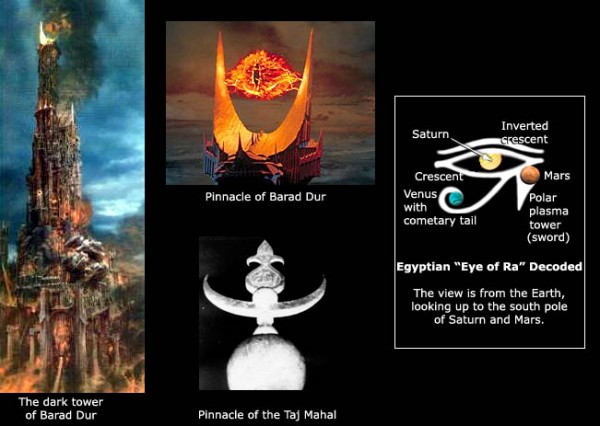holoscience.com | The ELECTRIC UNIVERSE®
A sound cosmology for the 21st century

Cassini’s Homecoming

”Nothing so evokes gasps of delight as Saturn’s ring. The reason I think, is a collision of the expected and the improbable. A ringed sphere is the archetypal planet of our childhood, familiar from a thousand comic strips, coloring books, classroom poster boards, stickers, rubber stamps, birthday cards — you name it. So, when we see Saturn, there is a kind of instant recognition, like meeting a relative one knows only from the family photo album. But there is also the shock of reality, a sense of ‘Oh my God, it actually exists!”
– Chet Raymo.
From the NY Times of June 15, 2004:
“The Saturn system represents an unsurpassed laboratory, where we can look for answers to many fundamental questions about the physics, chemistry and evolution of the planets and the conditions that give rise to life,” Dr. Edward J. Weiler, associate administrator for science at NASA, said in a statement.
Scientists dare not predict the discoveries waiting to be made as the spacecraft focuses its cameras and instruments repeatedly on Saturn and its signature rings and takes the measure of the icy moons during at least 76 orbits.
“Prepare to be amazed,” Dr. Carolyn Porco, head of the mission’s imaging team, said in an interview last week.
— John Noble Wilford
Scientists hope that the US$3.7 billion spacecraft will solve many of Saturn’s mysteries. However, if the Galileo mission to Jupiter is any guide, Cassini will discover more mysteries during its extended visit to Saturn. Scientists “dare not predict the discoveries waiting to be made” because their success rate in the past has been appalling. The catch phrase “it’s back to the drawing board” has been worn out. The old drawings are merely scribbled over. The problem for scientists analyzing the flood of data to be returned from Cassini and its probe to Titan is the set of unshakeable beliefs they bring to the task. The belief in the nebular accretion theory of formation of the solar system colors every confident assertion. For example, the official caption for this close-up of Saturn’s moon, Phoebe, reads:
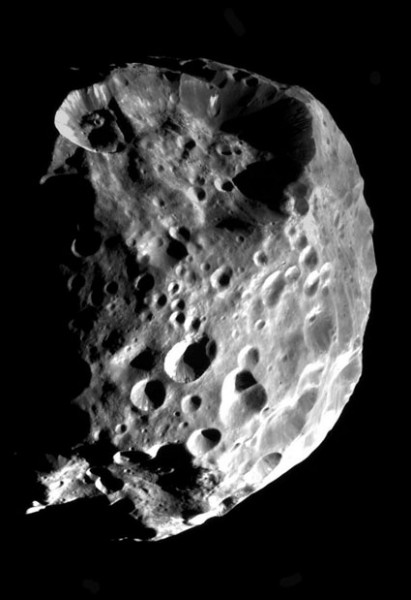
That the craters on Phoebe were formed by impact is stated as a fact. Instead, it is a supposition unsupported by observation or experiment. The ELECTRIC UNIVERSE® model explains the craters as Phoebe’s birthmarks. It is a model supported by examination of spark-machined surfaces. Just as stars are observed to do, gas giant planets may also expel a jet of matter during periods of electrical instability. Accretion of matter in the jet is mediated by the electromagnetic pinch effect and electrostatic deposition. Both of these mechanisms are far superior to accretion by impacts (tending to shatter and scatter instead of to accrete). Electrostatic deposition easily creates the layering seen in all rocky objects to date. Electrical discharges between the parent and departing child carve out the circular craters. Because they are not formed by a sudden mechanical impact, the craters are neat and do not cause disruption to adjacent craters or fill them with debris — as we see on Phoebe. That is not to say that Phoebe was born from Saturn. Its retrograde orbit suggests capture by Saturn.
Other limiting beliefs concern gravity and the electrical neutrality of celestial objects. Either one is sufficient to cause misleading or wrong deductions about Saturn and Titan,— the two major targets of the Cassini mission. Newton’s famous law of gravitation relates the force between two bodies to the product of their masses and the square of the distance between their centers. But ‘mass’ and its relation to matter remains a metaphysical concept. However, we know from particle accelerator experiments that the mass of a particle of matter increases when subjected to acceleration in an electromagnetic field. So the internal electromagnetic state of a planet or a star may alter its apparent mass. Yet scientists calculate the mass of Saturn or its moon, Phoebe, by measuring the gravitational force and assuming a universal constant of gravitation, written ‘G.’ In an ELECTRIC UNIVERSE® ‘G’ is neither universal nor constant. We cannot simply calculate the density of celestial bodies by estimating mass using Newton’s law of gravity.
In Saturn’s case, using Newton’s law, it is calculated that it is 95 times more massive than the Earth, which gives it a mean density only 0.7 that of water. Given a big enough bath, Saturn would float! The ELECTRIC UNIVERSE® model suggests that Newton’s law will not give a true picture of the planet’s density and therefore of its composition. Saturn may have considerably more heavy elements than its gravity would suggest. Low gravity suggests low internal electric stress. And that may tell us something about Saturn’s recent history.
The belief in the electrical neutrality of the universe has led to the theory that stars must generate their energy by feeding on themselves. Despite decades of ad hoc adjustments, the theory still fails to explain most of the observed features of the Sun. The electric model of stars shows that the classification of stars and gas-giant planets on the basis of their calculated mass is incorrect. Stars are an electrical phenomenon and rely on their electrical environment for their mass, appearance and classification. Their cores do not burn with a thermonuclear fire and they are much cooler than the hot plasma discharge that envelops them. The Sun is stone cold compared to its corona. That is why the interior of the Sun, seen through its sunspots, is much cooler than the electrical storms that rage above in its photosphere. The bright plasma shell of a star, particularly giant stars, may be much larger than the solid core that is the focus of the cosmic discharge. Stars and gas giants may occasionally reduce internal electrical stress by ejecting some of their charged core, usually equatorially, in a nova type outburst. The light curves of novae show the typical rapid onset and slow decay of lightning. The result of the outburst is an expulsion disk and closely orbiting companions.
With that picture of an electric star in mind, the following scenario is proposed, stripped of the volumes of evidence available to support it. The test will be to see how predictive it turns out to be:
Until recently Saturn was an independent brown dwarf star with its own entourage of close-orbiting small planets. As a small star approaching the Sun, Saturn flickered like a faulty electric light when the two stellar magnetospheres (plasma sheaths) touched. Saturn’s electrical power was usurped by the Sun and its appearance changed dramatically. Such rapid variability in the appearance of stars is well documented. Before dimming forever, Saturn would have flared up to relieve the stresses caused by the sudden change in electrical environment. Saturn’s present low internal electrical stress, as indicated by its low apparent mass, suggests ejection activity. But even so, the core of the electric star has not completely cooled — Saturn still radiates more than twice the heat it receives from the Sun. And we have a simple explanation for the origin of Saturn’s mysterious short-lived rings.
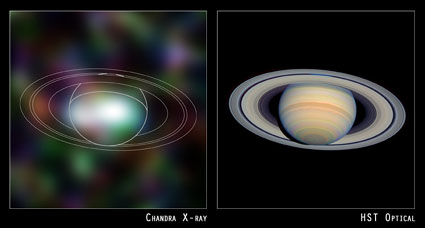
Like the Sun, Saturn radiates X-rays strongly from near its equator. This is quite different to Jupiter where the X-rays come from polar auroral discharges. Saturn’s X-ray spectrum is like the Sun’s, which led scientists to say that X-rays from the Sun were being reflected by Saturn’s atmosphere. That seems unlikely given the similarities between Saturn and Jupiter. It would require that Saturn reflect X-rays 50-times more efficiently than the Moon! Instead, Saturn still shows stellar characteristics. Saturn’s X-rays are concentrated, like the Sun’s, at low latitudes. Voyager 2 also found an immense, hot donut of plasma encircling Saturn that is believed to be the hottest in the solar system, 300 times hotter than the solar corona. (Temperature estimates are misleading if particle motions are non-random, which is the case in electric discharges).
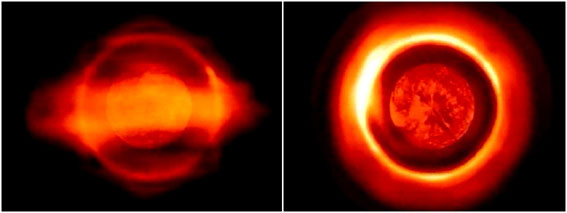
Saturn’s rings form part of the circuit that feeds energy into its plasma donut, where it is stored before discharging into Saturn’s ionosphere and generating X-rays. The Sun has a similar plasma donut that discharges to the Sun, causing sunspots and solar flares. We might then expect Saturn’s storms to show similar behavior to sunspots, which are the Sun’s electrical ‘storms.’
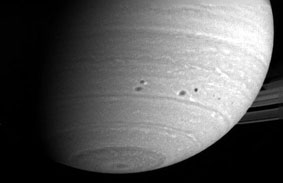
Saturn occasionally ‘burps,’ creating a great white spot 3 times the size of the Earth. It is inexplicable on standard models. However, it is the kind of thing to be expected following an exceptionally powerful lightning discharge deep into Saturn’s atmosphere. The discharge forms a vertical jet of matter from the depths that spouts into the upper atmosphere. Saturn’s high-speed equatorial winds are also driven electrically and they have been observed to diminish in speed from 1,700 km/hr to 1,000 km/hr since the Voyager flybys. That may tie in with the disappearance of the mysterious ‘spokes’ in Saturn’s rings that were discovered in Voyager images in the early 1980’s. Radial lightning, 10,000 times as powerful as lightning bolts on Earth, form the spokes across the rings to Saturn’s ionosphere. Reduced electrical activity at Saturn would be expected to reduce the occurrence of ring spokes and to slow the equatorial winds.
Saturn’s ephemeral rings are strong evidence in favor of recent ejection. The term “recent” in relation to Saturn’s ring structure means tens of thousands of years. That’s how long astronomers calculated it would take for gravity to cause them to rain down upon Saturn. However, there is more to the ring structure than gravity can explain. If a 1-meter wide model of Saturn were made the rings would be 10,000 times thinner than a razor blade! Equatorial currents at Saturn are responsible for the thinness and odd dynamics of the rings, so gravity-based calculations of their age are misleading. More evidence for recent ejection came when Voyager 1 discovered radio discharges that were diagnosed as a continuous electrical storm stretching over 60 degrees in longitude near Saturn’s equator! Something much larger than Phoebe must have erupted from Saturn, creating the rings and leaving a scar on the surface (like Jupiter’s Great Red Spot) that has not yet healed. If so, where are Saturn’s children now?
By this stage, cognitive dyspepsia will have taken its toll of those readers who have faith in the established fairytale of a solar system formed gravitationally 5 billion years ago, with the planets in the same order and roughly the same orbital spacing as we find them now. For them there is much more that could be written to prepare the way for this radically new paradigm. That task will be undertaken by a new website called thunderbolts.info. For the moment, a scenario follows that is so alien to any conventional theory of Saturn’s history that it should be easily tested against information gained from the Cassini mission. It shows striking connections between many seemingly unrelated facts about certain planets. That is something that conventional cosmogony has not been able to do.
Saturn and the Recent History of the Solar System
The challenge to convention begins with the use of the words “Recent History.” The solar system is not supposed to have a recent history. We assume that the dinosaurs roamed under the same Sun we see in the sky today. But no, in round figures I am talking about changes in planetary orbits only 10,000 years ago. The changes occurred during the era of the earliest human art in the form of petroglyphs, or rock carvings. The petroglyphs are not merely prehistoric doodles on rock. They required a prodigious global effort by our distant ancestors to produce. The breakthrough in decoding them came when the strange petroglyphs were compared with powerful electrical discharge phenomena. [My earlier news item, Mystery of Mars’ Polar Spirals, outlines some recent results in the search for the true meaning of petroglyphs.]
It is now clear that petroglyphs are an enduring record of the frightening collapse of a former cosmos. It has taken 10,000 years for us to be able to see in laboratory plasma discharge experiments what our forebears saw in awesome cosmic proportions in the sky. We can now understand why the first civilizations were obsessed with the capricious and warring planetary gods, who fought with thunderbolts, when today we can hardly identify those planets in the sky. With a real perspective of chaos in the solar system in prehistoric times we can see why the astronomer-priests of old were so powerful in their societies. They knew planets had had a dramatic impact on humanity and the Earth. And Saturn was remembered as the most prominent. The solar system as we see it today is less than 10,000 years old!
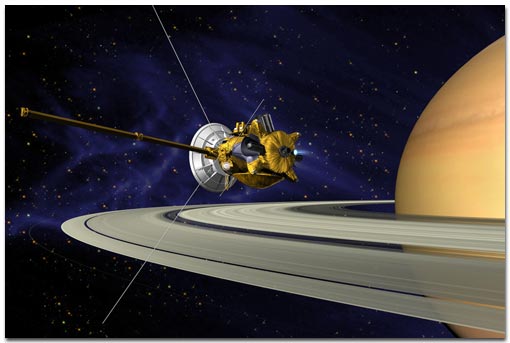
All being well, Cassini is due to arrive at Saturn on July 1. Only a select few on Earth recognize the event as a kind of homecoming; a homage to our most ancient Sun god ‘ Sol, Ra, Helios. All of these names were originally given to the planet Saturn. Yet Saturn today is an unremarkable speck in the sky, less bright than many of the brightest stars.
In recent news reports, Saturn has been called the original ‘Lord of the Rings.’ There is a profound truth behind such a glib by-line. But it wasn’t until the advent of the telescope that Christian Huygens, in 1656, was able to suggest that Saturn had a ring. So how do we explain that Saturnian symbolism of the ring pervades our cultures? The halo of the saints, the royal crown, and the ring given in marriage are Saturnian symbols, as are the circled or Celtic cross, the Egyptian ansate cross, or ankh, the “Eye of Ra,” and the star inside the crescent. The star at the top of the Christmas tree, covered in lights, is pure Saturnian imagery. It is truly amazing that we are still haunted by prehistoric archetypes. It helps us to understand the extraordinary subconscious attraction of Tolkien’s fantasy of Lord of the Rings. J. R. R. Tolkien was well versed in mythology.
In December, 1999, I wrote in Other stars, other worlds, other life?
“If the following sounds like science fiction, so be it. Science fiction writers are far better than experts at predicting future knowledge. What then might be the Earth’s history? The distant orbits from the Sun suggest that we were captured along with our Brown Dwarf parent. In the process, the electric power that drove our parent star was usurped by the Sun. As well as turning out the primordial light, the Sun stripped the Earth from its mother’s womb along with the Moon. Night fell for the first time and stars appeared. Ice ages began suddenly. The polar caps formed. High latitudes became uninhabitable. It is worth adding that many of the moons, or remaining offspring, of the gas giants have surprisingly icy surfaces and some have atmospheres. Life may have existed once on Mars and some of those moons.”
As the ancients observed, Saturn was our primordial parent star. Of course we must be careful in our identification. But there is one physical characteristic that links the parent with its offspring. It is the axial tilt. Like our moon, satellites tend to orbit their primary with the same face always turned toward it. If they orbit in the equatorial plane, their spin axis will be aligned with that of the primary. As gyroscopes, the satellites will retain the same tilt even if jolted from their orbit, although the process may induce a wobble of the spin axis. It is therefore highly significant that two key planets identified by the ancients — Saturn and Mars — have axial tilts closely similar to that of the Earth. The tilt of Saturn, at 27 degrees to the ecliptic plane, is itself an enigma — unless it formed independently from the Sun.
But Venus was also identified as a spectacular discharging comet in the ancient congregation of planets. What can be made of that? It can be explained if Venus was the latest child of Saturn. As explained earlier, Saturn shows the symptoms of having given birth recently. The birth would be triggered by a sudden change in Saturn’s electrical environment when it crossed from interstellar space into the Sun’s plasma envelope, or heliosphere. The voltage drop across the Sun’s plasma sheath would almost equal the full driving potential of the Sun, measured in tens of billions of volts. Rather than being an anode in the galactic discharge, Saturn would become a cathode in the Sun’s environment and subject to forming cathode jets. Saturn could be expected to ‘spit the dummy’ in such a circumstance! Venus was one such ‘dummy,’ ejected from the equator of Saturn. Saturn’s swift rotation delivered a ‘slap on baby’s bottom’ to Venus giving it a slow retrograde spin. The magnitude of the axial tilt of Venus to the ecliptic is much less than Saturn’s, which suggests that the Venusian orbit was tilted away from Saturn’s equatorial plane due to electrical capture forces acting on that dying star. We have abundant pictorial evidence that Venus was wrenched from its orbit in a polar direction shortly after it was born. (See the Egyptian “Eye of Ra” above).
This account explains many odd things about Venus; its slow retrograde spin; its hellish temperature, having being born recently from the core of a brown dwarf star; its thick atmosphere inherited from the brown dwarf and subsequently modified by cosmic discharges; and its equatorial scars caused by spectacular radial discharging, which was faithfully recorded by the petroglyph artists. Venus carried away significant charge from its parent so that it still has a ‘cometary’ magnetotail and its mountains glow with plasma discharges. Venus also shows a surprisingly young surface that gave rise to ad hoc theories of resurfacing events. They are unnecessary. Venus is a baby.

What can we expect Cassini to find, based on this dramatic recent history of Saturn? We should expect to see family traits amongst the members of the Saturnian family — including the departed Earth, Mars and Venus. For example, the moon Titan, which is larger than the planet Mercury, seems to be a close sibling of Venus, probably born from Saturn at about the same time. That Titan may be young is hinted at by its eccentric orbit, which cannot have persisted for billions of years. So we should be alert to similarities between Titan and Venus. It is already known that Titan has the densest atmosphere of any terrestrial planet, after Venus. That is a huge puzzle for scientists. After all, two of Jupiter’s moons, Ganymede and Callisto, have no atmosphere yet they are of similar size. So it would not be surprising if Titan had warm spots over the poles, like Venus. Titan also has a global layered haze like Venus. (Haze layers seem to be the condensed form that non-polar molecules take in an electrified atmosphere. They are quite distinct from the vertically moving clouds that polar molecules, like water, form). And just as Mars has a whiff of the Venusian atmosphere, with carbon dioxide and nitrogen as major constituents, we may expect to find that the Titan atmosphere has some of the smell of Venus about it. Both Venus’ and Titan’s atmospheres, being very young, will not yet be in equilibrium. So calculations about atmospheric constituents that assume equilibrium as a starting point will be wrong. The methane found in Titan’s atmosphere is quickly destroyed by sunlight so it has to be replenished. That has led to the suggestion that Titan must have a hydrocarbon ocean for the methane to have lasted for the conventional age of the solar system. However, radar, infrared and radio observations of Titan have not found signs of a hydrocarbon ocean. In fact one radar return was “of a type that we would expect to get back from Venus.” Titan is most likely a baby brother of Venus!
We should not overlook the fact that so many of the satellites are comprised of a large proportion of water ice, as are Saturn’s rings. It offers an explanation for the origin of the Earth’s amazing abundance of water. So we should not be surprised if, under the orange haze, that Titan has copious ice or water. We must await the descent of the Huygens probe into Titan’s atmosphere for answers. That raises the obvious question; why doesn’t Venus have much water? When performing comparisons, we must allow for the fact that the Venusian atmosphere is being modified continually by electric discharge activity on the surface of that planet. It has increased the carbon dioxide content of the Venusian atmosphere at the expense of nitrogen and water vapor. Scientists think that most of Venus’ water must have split into hydrogen and oxygen and all the hydrogen was lost to space. But if so, where is the oxygen that was left behind? The four Pioneer probe craft didn’t find it in the atmosphere. The answer is that it has combined with carbon monoxide to form a heavy atmosphere of carbon dioxide. The process I envisage is this:
Venus probably began with an atmosphere more like Titan’s and the Earth’s, where nitrogen dominates, and with more water. It suggests that Saturn must have considerable nitrogen at depth in its atmosphere. The icy rings and satellites of Saturn and abundant water on Earth also point to water on Saturn. On the Venusian surface, nitrogen molecules are converted to carbon monoxide molecules by a catalytic nuclear reaction in the presence of red-hot iron. The brilliant French chemist, Louis Kervran, when investigating carbon monoxide poisoning of welders, discovered this surprising nuclear transformation. The carbon monoxide reacts at the hot surface of Venus with water vapor to form carbon dioxide and hydrogen. It is a well-known industrial process. The hydrogen produced escapes from Venus. This process explains the puzzling discovery made by Venus-landers that the water vapor concentration diminished as they approached the Venusian surface. A purely chemical approach to the puzzles of the Venusian atmosphere is not likely to work.
Like Venus, surface temperatures are globally uniform on Titan within a few degrees. It is thought that there is a greenhouse effect operating on Titan. However, the heat of Venus is due to its origin and has nothing to do with a greenhouse effect. The same will likely be true for Titan. Like Venus, Titan seems not to have a magnetic field and yet it has a distinct magnetotail. Titan’s electrical plasma interactions may be like those of Venus. Titan shines on the dayside in UV light too brightly to be explained by solar radiation. It should be very interesting as Titan swings in and out of Saturn’s magnetosphere. The plasma sheath crossings could provide some surprises.
There is much more that could be written about Saturn’s other moons. But there are enough outrageous claims here to add spice to the anticipated revelations from Cassini’s extended visit to Saturn and the Huygens probe to Titan.
Wal Thornhill
